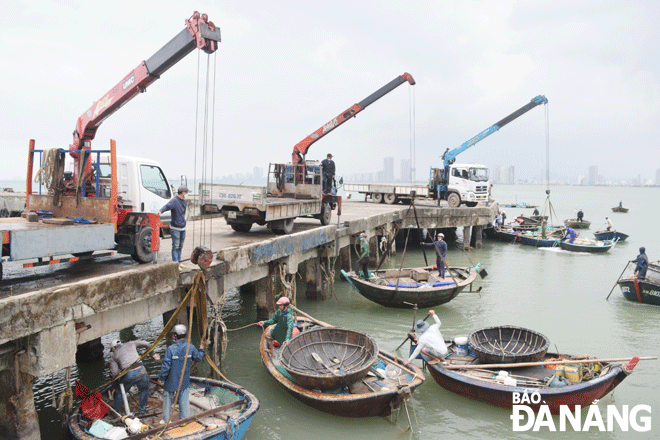Storm season expected to be complicated till end of year
At the beginning of the rainy and stormy season, Da Nang and other central provinces have just been directly affected by typhoon Noru, the strongest storm in the past 20 years. However, the damage has been minimised as the municipal government has joined efforts with local people to make all necessary preparations.
 |
| Fishermen are seen urgently pulling small boats ashore to avoid recent typhoon Noru. Photo: HOANG HIEP |
In the latest round of interviews, Director of the Hydrometeorological Station of the Mid-Central Region Dinh Phung Bao gave his opinions and assessments on the developments of rain, storms and floods in the rainy and stormy season in 2022.
From now until the end of 2022, it is forecasted that the East Sea area will witness about 4 - 6 storms and tropical depression. Among them, 2 - 4 of which can directly affect the Viet Nam mainland, about 1 - 3 of which are expected to hit the mid-Central region from Quang Binh to Quang Ngai provinces. In particular, Da Nang is also likely to be affected by 1-2 storms and tropical depressions.
Based on aforementioned forecasts, vulnerable localities need to watch out for storms with complicated and intense movements from now until the end of 2022. Until January 2023, there is still a possibility of tropical cyclones, rapidly rotating storm systems characterised by low-pressure centres in the southern part of the East Sea.
The rainfall measured in the rainy season in 2022 in localities in the Mid- central region is approximately and higher than the average of many years, expected to reach 100-150%.
Regarding large-scale heavy rain, from now until the end of this ongoing rainy season, in the Mid-central region, there is a possibility of 5-7 large-scale heavy rains occurring during the peak of the rainy and stormy season. In Da Nang alone, there is a possibility of 4-6 heavy rain sessions. Heavy rains are likely to cause a high risk of flooding in low-lying areas in river basins, flash floods and landslides in mountainous areas and the upstream of rivers.
Regarding floods, from October to December, the Mid-central region is likely to be affected by 3-5 floods with flood peaks in rivers at alarm levels. The highest flood peaks of the year are likely to appear in October and November.
As mentioning to the main causes for such extreme weather, it is forecasted that the ENSO phenomenon is likely to continue to remain in the La Nina state from now until the end of 2022 with a probability of about 80 - 90% and it is likely to last into the first months of 2023. The La Nina state is the main cause of complicated and extreme weather changes. Another reason is that global warming is increasing the frequency of extreme weather events.
During the rainy and stormy season in 2020, Central Viet Nam has suffered a series of consecutive and rapid natural disasters. Within 41 days, this region was directly affected by 6 storms and one tropical depression. According to the latest forecasts, from now to the end of 2022, the Mid-central region is likely to experience major natural disasters, peaking in October and November.
Natural disasters are increasingly complicated as storms and heavy rains tend to increase in intensity and frequency of occurrence, and especially, heavy rains often have a high risk of causing flash floods and landslides, causing many difficulties for disaster forecasting in the region.
However, in order to further improve the ability to release accurate forecast for natural disasters, it is necessary to strengthen the modern hydrometeorological monitoring network with a focus on the upstream areas of rivers, streams and high mountains in order to provide adequate information and data for disaster forecasting and warning.
At the same time, sight will be kept on promoting the application and extensive implementation of scientific research in the field of forecasting and warning of natural disasters, step by step improving the quality of human resources, perfecting the systems of data collection and warnings about natural disasters, in order to ensure the effectiveness of forecasting and warning work, thus helping to overcome possible natural disasters-triggered consequences.
The application of modern science and technology in burgeoning Industry 4.0 will help overcome the inadequacies and limitations in stages such as monitoring, measuring, storing and processing data to perfect the project technology.
Reporting by HOANG HIEP - Translating by A.THU